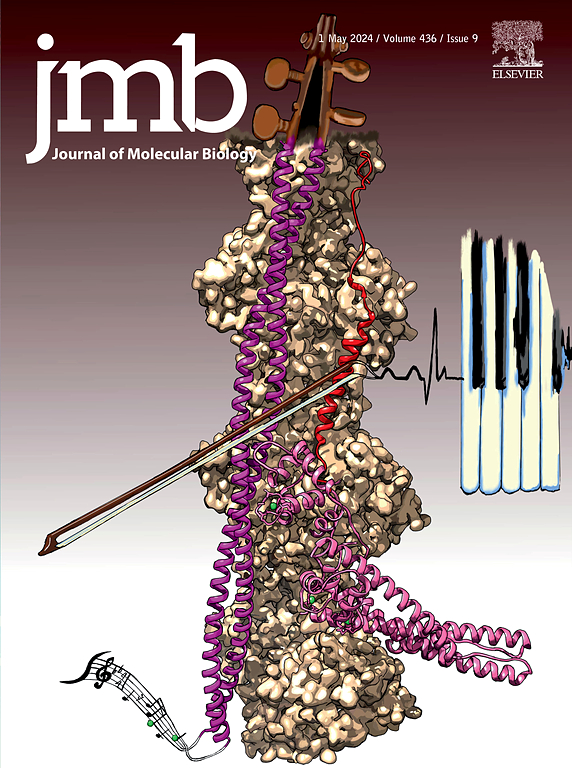Chaperone Activity of SARS-CoV-2 Nucleocapsid Protein: RNA Annealing and Destabilization Mechanisms
IF 4.7
2区 生物学
Q1 BIOCHEMISTRY & MOLECULAR BIOLOGY
引用次数: 0
Abstract
The recent global COVID-19 pandemic has prompted new research in coronaviruses. Despite the discovery of effective vaccines and therapeutic interventions, coronaviruses remain a threat to humans as the emergence of novel variants or new pathogenic coronaviruses is possible. The N protein or nucleocapsid protein, belonging to the virus’ essential proteins, is mainly involved in the compaction and protection of the viral genome. Here, we show that the SARS-CoV-2 N protein is a very efficient chaperone protein of nucleic acids that aggregates nucleic acids and anneals well-folded and complementary oligonucleotides hairpins in vitro. Using fluorescence and gel shift electrophoresis methods, we showed the high ability of the protein to destabilize nucleic acid secondary structure and to anneal nucleic acid strands. This last activity needs the full-length protein as we demonstrate that protein fragments, while they could display some activities, are considerably less efficient. However, the ability of the full-length protein to destabilize small double-stranded RNAs is poor. Our results show that the N protein possesses a chaperone activity similar to the HIV-1 NCp7 and NCp9 nucleocapsid proteins known as powerful nucleic acid chaperons.

SARS-CoV-2核衣壳蛋白的伴侣活性:RNA退火和不稳定机制。
最近的全球COVID-19大流行引发了对冠状病毒的新研究。尽管发现了有效的疫苗和治疗干预措施,但冠状病毒仍然是对人类的威胁,因为有可能出现新的变体或新的致病性冠状病毒。N蛋白或核衣壳蛋白属于病毒的必需蛋白,主要参与病毒基因组的压实和保护。在这里,我们证明了sars - cov - 2n蛋白是一种非常有效的核酸伴侣蛋白,可以在体外聚集核酸并降解折叠良好的互补寡核苷酸发夹。利用荧光和凝胶移位电泳方法,我们发现该蛋白具有破坏核酸二级结构稳定和退火核酸链的高能力。最后一种活性需要全长的蛋白质,因为我们证明了蛋白质片段虽然可以显示一些活性,但效率要低得多。然而,全长蛋白破坏小双链rna稳定的能力很差。我们的研究结果表明,N蛋白具有与HIV-1 NCp7和NCp9核衣壳蛋白类似的伴侣活性,被称为强效核酸伴侣蛋白。
本文章由计算机程序翻译,如有差异,请以英文原文为准。
求助全文
约1分钟内获得全文
求助全文
来源期刊

Journal of Molecular Biology
生物-生化与分子生物学
CiteScore
11.30
自引率
1.80%
发文量
412
审稿时长
28 days
期刊介绍:
Journal of Molecular Biology (JMB) provides high quality, comprehensive and broad coverage in all areas of molecular biology. The journal publishes original scientific research papers that provide mechanistic and functional insights and report a significant advance to the field. The journal encourages the submission of multidisciplinary studies that use complementary experimental and computational approaches to address challenging biological questions.
Research areas include but are not limited to: Biomolecular interactions, signaling networks, systems biology; Cell cycle, cell growth, cell differentiation; Cell death, autophagy; Cell signaling and regulation; Chemical biology; Computational biology, in combination with experimental studies; DNA replication, repair, and recombination; Development, regenerative biology, mechanistic and functional studies of stem cells; Epigenetics, chromatin structure and function; Gene expression; Membrane processes, cell surface proteins and cell-cell interactions; Methodological advances, both experimental and theoretical, including databases; Microbiology, virology, and interactions with the host or environment; Microbiota mechanistic and functional studies; Nuclear organization; Post-translational modifications, proteomics; Processing and function of biologically important macromolecules and complexes; Molecular basis of disease; RNA processing, structure and functions of non-coding RNAs, transcription; Sorting, spatiotemporal organization, trafficking; Structural biology; Synthetic biology; Translation, protein folding, chaperones, protein degradation and quality control.
 求助内容:
求助内容: 应助结果提醒方式:
应助结果提醒方式:


